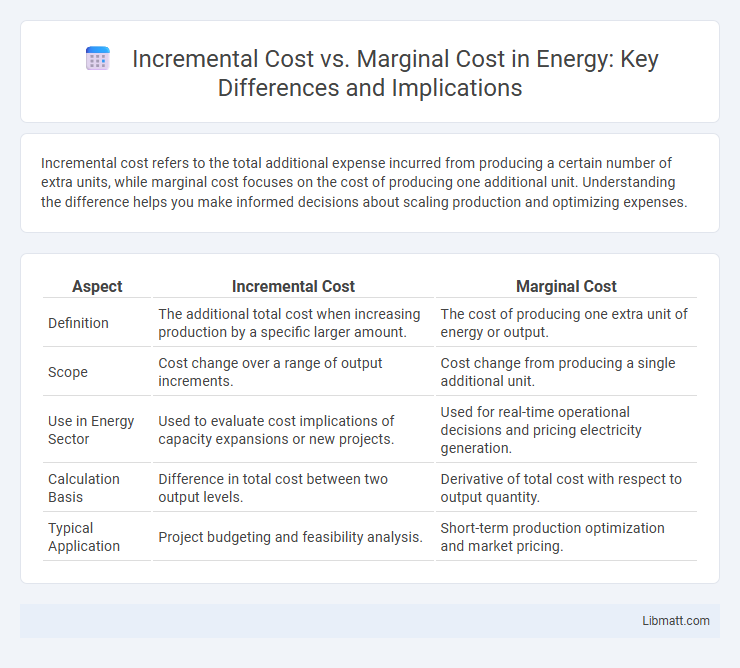Incremental cost refers to the total additional expense incurred from producing a certain number of extra units, while marginal cost focuses on the cost of producing one additional unit. Understanding the difference helps you make informed decisions about scaling production and optimizing expenses.
Table of Comparison
| Aspect | Incremental Cost | Marginal Cost |
|---|---|---|
| Definition | The additional total cost when increasing production by a specific larger amount. | The cost of producing one extra unit of energy or output. |
| Scope | Cost change over a range of output increments. | Cost change from producing a single additional unit. |
| Use in Energy Sector | Used to evaluate cost implications of capacity expansions or new projects. | Used for real-time operational decisions and pricing electricity generation. |
| Calculation Basis | Difference in total cost between two output levels. | Derivative of total cost with respect to output quantity. |
| Typical Application | Project budgeting and feasibility analysis. | Short-term production optimization and market pricing. |
Understanding Incremental Cost
Incremental cost represents the total increase in expense resulting from producing an additional unit of output, encompassing all variable costs directly tied to the production increase. It helps businesses evaluate the financial impact of scaling operations, guiding decisions on whether expanding production is economically viable. Understanding your incremental cost allows for more precise budgeting and pricing strategies by identifying how costs change with output levels.
Defining Marginal Cost
Marginal cost refers to the additional expense incurred when producing one more unit of a good or service, calculated by dividing the change in total cost by the change in quantity produced. It is a crucial concept for businesses optimizing production levels and pricing strategies, as it highlights the cost impact of small-scale output adjustments. Understanding marginal cost enables you to make informed decisions on production efficiency and profit maximization.
Key Differences Between Incremental and Marginal Cost
Incremental cost refers to the total additional expense incurred when increasing production by a discrete amount, such as producing 100 more units, while marginal cost calculates the cost of producing just one additional unit. Incremental cost captures cumulative changes in costs over a specific increase in output, whereas marginal cost analyzes the cost impact of the very next unit produced. Understanding these differences helps you accurately assess cost behavior and make informed production decisions.
How to Calculate Incremental Cost
Incremental cost is calculated by determining the total increase in cost when producing one additional unit of output compared to the previous total production level. It involves subtracting the total cost at the current production level from the total cost at the higher production level and dividing by the number of additional units produced. This calculation helps businesses evaluate the expense of expanding production without considering fixed costs that remain unchanged.
Calculating Marginal Cost in Practice
Marginal cost is calculated by dividing the change in total cost by the change in output quantity, focusing on the cost of producing one additional unit. Incremental cost considers the overall increase in costs from producing multiple extra units, but marginal cost isolates the cost impact per single unit. Understanding your marginal cost helps optimize production decisions and pricing strategies for maximum profitability.
Incremental Cost: Practical Examples
Incremental cost represents the additional expense incurred from producing one more unit or implementing a specific decision, such as launching a new product line or expanding a manufacturing plant. For instance, a bakery calculating the incremental cost of baking 100 extra loaves includes expenses for additional flour, labor, and electricity directly associated with those loaves. These practical examples highlight how businesses assess incremental costs to make informed decisions that affect overall profitability and resource allocation.
Marginal Cost: Real-World Applications
Marginal cost plays a critical role in pricing strategies and production decisions within various industries such as manufacturing, retail, and services, helping businesses determine the cost of producing one additional unit of output. Understanding your marginal cost enables efficient resource allocation to maximize profit by identifying optimal production levels where the cost of producing an extra unit equals the revenue it generates. Real-world applications include optimizing supply chain logistics, scaling production during peak demand, and making investment decisions in new product lines or capacity expansion.
Impact on Business Decision-Making
Incremental cost measures the additional expense incurred when increasing production by a specific amount and directly influences pricing strategies and budget allocations. Marginal cost represents the cost of producing one more unit, crucial for optimizing production levels and maximizing profit margins. Understanding both costs allows businesses to make informed decisions on scaling operations, pricing, and resource management to enhance overall financial performance.
Incremental Cost vs Marginal Cost: Pros and Cons
Incremental cost measures the total added expense from producing additional units, making it useful for evaluating business decisions that involve larger production changes, while marginal cost focuses on the cost of producing one more unit, ideal for fine-tuning pricing strategies. Incremental cost offers clarity for budgeting and long-term planning but may oversimplify unit-level variations, whereas marginal cost provides precision in cost control but can be volatile with fluctuating production volumes. Understanding the pros and cons of both costs helps you optimize production efficiency and pricing decisions effectively.
Selecting the Right Cost Analysis for Your Business
Incremental cost measures the total change in cost when producing additional units, while marginal cost calculates the expense of producing one extra unit. Selecting the right cost analysis depends on your business scale and decision-making needs; incremental cost suits scenarios involving batch production changes, whereas marginal cost is ideal for optimizing single-unit output. Accurate application of these analyses enhances pricing strategies and resource allocation.
Incremental Cost vs Marginal Cost Infographic

 libmatt.com
libmatt.com